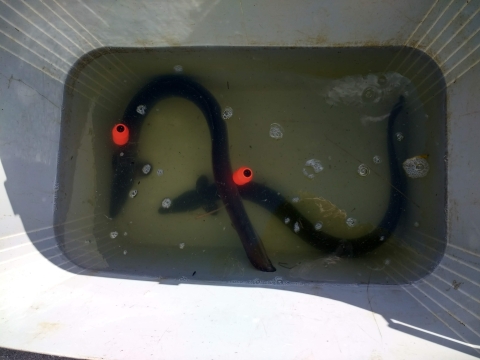European eels, who are they and where are they going to?
Since very recently, VLIZ, the INBO and the Marine Biology Research Group of Ghent University started tagging eels with pop-up data storage tags, a new type of tag, to reveal marine migration routes of European eel.

The European eel (Anguilla anguilla (Linnaeus, 1758)) is a critically endangered fish species, the recruitment of which has declined by 90 – 99% since the 1970s. In order to stop the decline of the endangered European eel, all European countries are obliged to set up an eel management plan and support this with scientific data. Particularly downstream eel migration, when maturing eels migrate from their freshwater habitat to the open ocean, is thought to be a critical phase in the eel's life cycle. On their way to the ocean, eels have to face several challenges such as sluices and pumping stations. We need to understand how these barriers affect the chances of eels to reach the sea, to reveal whether constructions such as fish passages indeed have a positive impact and to create innovative solutions to facilitate migration.
Furthermore, many fundamental knowledge gaps in the eels’ complex lifecycle still exist. As an example, the exact location of the spawning grounds, and the marine migration routes to the presumed spawning grounds in the Sargasso Sea, have not yet been elucidated. Mapping these routes and understanding the migration behavior can teach us how eels handle their available bio-energy budgets for successful spawning, and what potential bottlenecks (e.g. effects of pollution, non-native parasites and delays near migration barriers) may jeopardize successful migration and consequently spawning. In order to restore the European eel population, it's crucial to understand the behavior, habitat use and migration patterns of the eel.
To address some of the above-mentioned knowledge gaps, the Flanders Marine Institute (VLIZ), the Research Institute for Nature and Forest (INBO) and the Marine Biology Research Group (MarBiol) at Ghent University tag eels with acoustic transmitters, which can be detected by the elaborated acoustic tracking network and pop-off data storage tags (pDSTs) in the framework of the European LifeWatch project. The pDSTs record temperature and pressure and pop off after a predefined time (6 or 12 months).
If you would find a tag, please contact us (Pieterjan.Verhelst@UGent.be or jan.reubens@vliz.be), so we can retrieve the tag and the valuable information it contains.
So far 392 European eels have been tagged with acoustic tags and 24 with pDSTs in the LifeWatch network.


Furthermore, many fundamental knowledge gaps in the eels’ complex lifecycle still exist. As an example, the exact location of the spawning grounds, and the marine migration routes to the presumed spawning grounds in the Sargasso Sea, have not yet been elucidated. Mapping these routes and understanding the migration behavior can teach us how eels handle their available bio-energy budgets for successful spawning, and what potential bottlenecks (e.g. effects of pollution, non-native parasites and delays near migration barriers) may jeopardize successful migration and consequently spawning. In order to restore the European eel population, it's crucial to understand the behavior, habitat use and migration patterns of the eel.
To address some of the above-mentioned knowledge gaps, the Flanders Marine Institute (VLIZ), the Research Institute for Nature and Forest (INBO) and the Marine Biology Research Group (MarBiol) at Ghent University tag eels with acoustic transmitters, which can be detected by the elaborated acoustic tracking network and pop-off data storage tags (pDSTs) in the framework of the European LifeWatch project. The pDSTs record temperature and pressure and pop off after a predefined time (6 or 12 months).
If you would find a tag, please contact us (Pieterjan.Verhelst@UGent.be or jan.reubens@vliz.be), so we can retrieve the tag and the valuable information it contains.
So far 392 European eels have been tagged with acoustic tags and 24 with pDSTs in the LifeWatch network.





